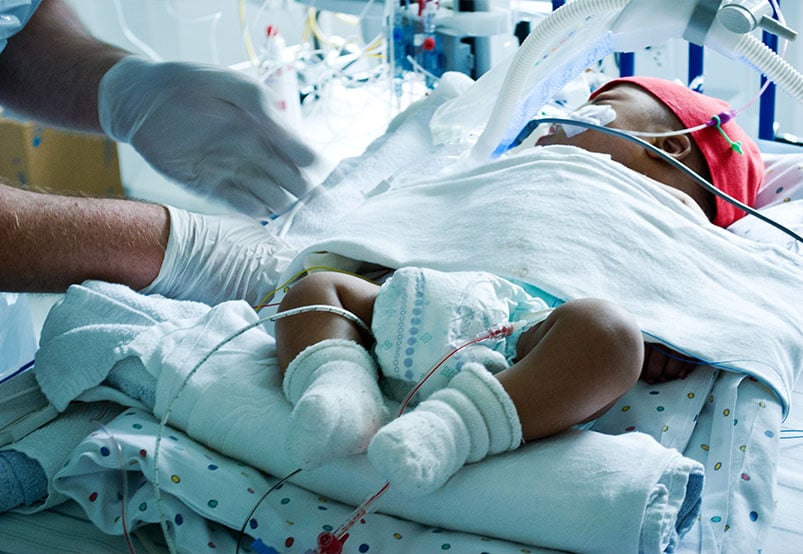%20(2).jpg?width=803&name=MIC-BLOG-Virtual-ICUs-Enhance-Hands-on-Care-v2%20(1)%20(2).jpg)
The staff was skeptical at first, Dr. Atiya Dhala remembered. The medical director of the newly launched virtual ICU at Houston Methodist had conducted town halls, retreats and many different meetings, all to gain the staff’s interest in the new technology.
The response was slow, Dr. Dhala said – until the pandemic hit Houston in March.
“Then the staff wanted it turned on quickly! We did the fastest wrap-up in the history of virtual ICU [launches],” she laughed, remembering the instant reversal in mood. With the contagious COVID-19 respiratory virus at their door, hospital staff immediately understood the advantage of gaining large amounts of patient data while limiting exposure from being at the bedside.
While the acceptance and popularity of virtual visits with a doctor have been on the rise in recent years, the concept of “telehealth” as it relates to tele-ICU and remote consults between care teams had not been as widely adopted in healthcare. As Dr. Dhala explained, staff often considered it an additional burden, rather than a potentially life- and time-saving solution. Many physicians were skeptical about their ability to deliver care without being at the bedside. That perception has been reversed, as tele-ICU capabilities quickly proved their worth during the COVID-19 crisis, one of the positive outcomes that she and other medical professionals will take from this pandemic.
Dr. Dhala recalled her hospital’s virtual ICU launch in comments she made during the American Telemedicine Association’s “Spotlight on COVID-19: Scaling ICU Beds and Capabilities” webinar, where she served as a panelist alongside Iris Berman, vice president of Telehealth at Northwell, and Dr. Hargobind Khurana, medical director of Tele Acute Care at Providence St. Joseph Health in Seattle. Anthony Reina, M.D., chief architect for Health & Life Sciences with Intel moderated the conversation, which centered on how healthcare organizations are using telehealth. A recording of the webinar, which was sponsored by Intel and MIC, is available here.
Ready for the Unexpected
Challenges related to tele-ICU implementation before COVID-19 hit included getting buy-in from staff and doing workflows, Dr. Dhala explained. But when the need changed as quickly as the virus spread, Houston Methodist was ready.
“The technology and infrastructure was set up, ready to scale to meet demands, and add providers quickly,” Dr. Dhala said. All of the static and dynamic data that the Houston Methodist team needed had already been interfaced with the platform. “The algorithms had been checked and verified, and we had risk scores and a clinical decision system to help rank our patients in terms of illness,” she explained.
“The software platform is the FDA-approved platform called Sickbay,” Dr. Dhala said. “This technology was nimble; we were able to turn it on easily and build it the way we wanted to build it. We worked with MIC [Medical Informatics Corp.] very closely, developing all these algorithms and they can turn on one bed in four minutes. It’s very nice.”
Houston Methodist went from 24 to 126 critical care COVID beds in under two weeks, turning beds on quickly to meet the fast-growing demand. “COVID was almost like a silver lining. Because of nimble technology, it was do-able,” Dr. Dhala explained. “Our Ops Center staff was already trained on it. For us, it was mostly turning on the beds and now having the buy-in.”
In the Pacific Northwest, COVID-19 also pushed forward implementation and widespread use of tele-technology. Seattle-area health systems quickly turned on tele-ICU capabilities to handle the incredible surge of patients that hospitals were receiving as the pandemic spread widely. “Things that wouldn’t have happened in years happened in days,” Dr. Khurana said.
COVID-19 has allowed a proof of concept, he explained, for sharing clinical resources through telehealth to provide care where it’s needed. Physicians from all parts of the country were able to remote into some of the hardest-hit areas, including the front lines in New York City, to take shifts and get more eyes on patients. Dr. Khurana and many of his colleagues took the opportunity to serve with Iris Berman’s team at Northwell.
“Having a glimpse into what New York had been doing for many weeks was humbling, and it showed the potential for a telehealth platform across systems and regions,” Dr. Khurana said, also adding that physicians were grateful for the opportunity to see more patients and gain insight into the pandemic while at the same time complementing on-the-ground teams. “It extended our reach tremendously by adding workforce via telehealth,” Berman said of the additional expertise that physicians were able to contribute.
As Berman’s team at Northwell in New York looks toward increasing bed capacity for what they are terming “long term acute care,” or “LTAC” pop-ups, staged in other parts of the hospital or at outside facilities, they will be using tele-ICU capabilities to get eyes on patients who need a higher level of care than even skilled nursing as they rehabilitate from time spent on a ventilator, for example. “Being able to use telemedicine to have tele-intensivists have insight into those facilities is probably going to be the next phase for us as we put carts into these facilities so that we can continue to wean and rehabilitate these very weak patients to give them extra time to get over this hurdle,” Berman said.
Tele-ICU capabilities also allow staff members who are in quarantine, but feeling fine, to continue working. Berman herself was quarantined for two weeks after she was exposed to the virus. “I was still able to continue my work, as have a number of people on my team,” she said. “As long as they’re not ill, you’re able to continue to utilize your workforce, using telehealth in this way.”
Compatibility Not a Concern
Dr. Reina raised the issue of compatibility, pointing out that even electronic health records don’t necessarily communicate seamlessly. Dr. Dhala emphasized that the technology her team uses at Houston Methodist allowed seamless communication.
“We have Epic, and the way we set it up is that Epic is integrated with our monitoring system, so at the click of a button, you can go from Epic to camera-ing into the room. So that is very user-friendly,” Dr. Dhala said.
It also allowed for greater communication between hospitals that weren’t equipped with the same capabilities as the flagship hospital. “The technology could be turned on even in our system hospitals where they didn’t have the hardware, so to speak,” Dr. Dhala explained. “They used the ready-made iPad but then used the software technology to tele-round from conference rooms, so they could go in remotely and camera in using their iPads.”
That same consultant bridge feature also allowed specialists like endocrinologists and cardiologists to consult with care teams without needing to be at the patient’s bedside. Through a secure and time-limited link sent from the operations center, those physicians could camera into the room.
Communication abilities like this have also proved invaluable in linking patients to their families, who are not allowed to visit them in the hospital.
“We would send a link to the family and could bring two or three family members from different states to be on the same call talking to their family member,” Dr. Dhala said. “We did a wedding, actually! The son was going to get married in September, but he said, ‘No no no, I want my mother to watch that!’”
Looking Forward
With its worth well proven, experts predict expansion of tele-ICU needs as part of healthcare’s overall telemedicine initiatives. Seeing the results it has offered in terms of increased efficiency, improved safety, and expansion of care to those most in need at any given time, those who utilize it today are positive that this is the way forward, for future waves of the pandemic and for the future of care delivery.
If your hospital is looking for ways to prepare for all waves of COVID and create a new standard of data-driven medicine and patient-centered care download our Raise the Line e-book.




